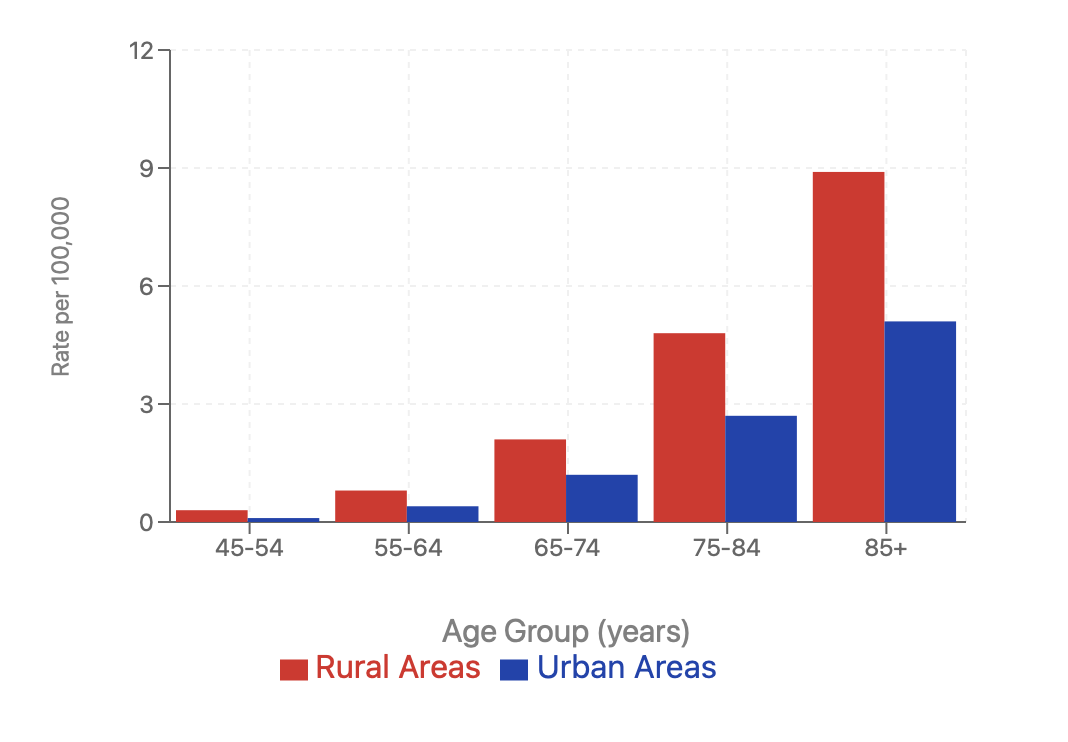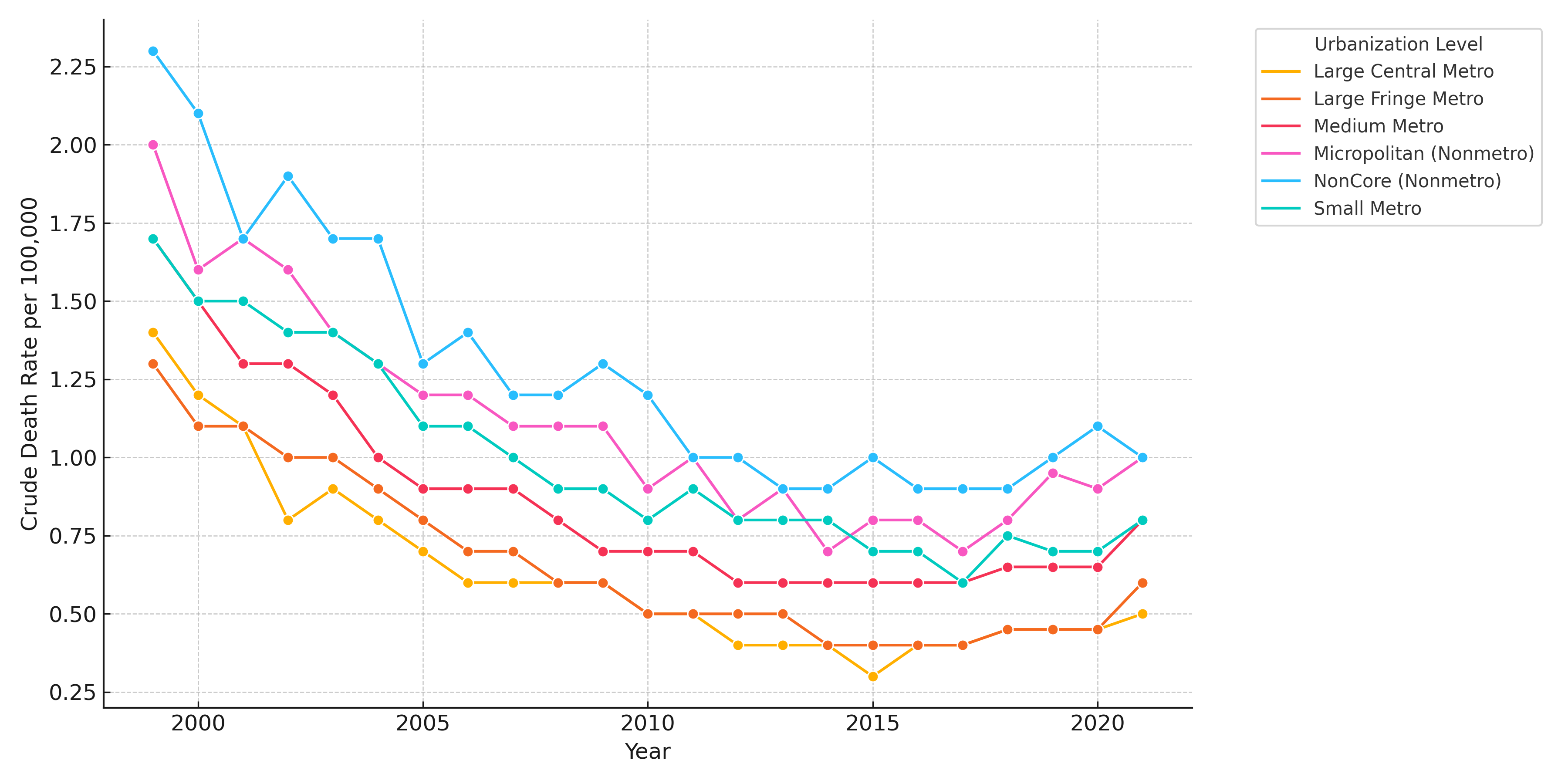Monday Poster Session
Category: Colon
P2427 - Ischemic Colitis: A Forgotten Rural Health Burden With Persistent Geographic Disparities, 1999-2021

Richeal Asante, MD
Geisinger Wyoming Valley Medical Center
Kingston, PA
Presenting Author(s)
1Geisinger Wyoming Valley Medical Center, Wilkes-Barre, PA; 2Geisinger Wyoming Valley Medical Center, Kingston, PA; 3Columbia University, Dumont, NJ; 4Korle-Bu Teaching Hospital, Accra, Greater Accra, Ghana; 5Mother and Child Hospital, Accra, Central, Ghana
Introduction:
Ischemic colitis disproportionately affects older adults and may exhibit geographic variation in mortality outcomes. Rural populations face unique healthcare access challenges that may influence disease-related mortality patterns. This study examines longitudinal trends in ischemic colitis mortality across the rural–urban continuum and identifies geographic disparities in crude mortality rates from 1999 to 2021.
Methods:
We analyzed CDC WONDER Multiple Cause of Death data from 1999 to 2021 to identify deaths attributed to ischemic colitis (ICD-10 codes K55.0 and K55.1). Crude mortality rates per 100,000 population were calculated annually and stratified by 2013 NCHS urbanization categories. Longitudinal trends were assessed across all urbanization tiers. Nonmetropolitan counties, defined as micropolitan and noncore areas, were classified as rural. Rate differences were compared across categories in 2021, the most recent complete data year.
Results:
From 1999 to 2021, ischemic colitis mortality rates declined in most metropolitan areas but remained elevated in rural regions. Between 2010 and 2021, noncore counties saw a 16.7% decrease in mortality, from 1.2 to 1.0 deaths per 100,000 population. In contrast, large central metropolitan areas maintained consistently lower rates of 0.5 per 100,000during this period. Despite these improvements, rural areas continued to bear a disproportionate burden. In 2021, noncore counties had double the crude death rate of large central metros (1.0 vs. 0.5 per 100,000). A persistent rural–urban mortality gradient was observed, with rates increasing progressively as areas became less urbanized. The highest mortality burden was observed among older adults and in the Southeastern United States.
Discussion:
While ischemic colitis mortality has declined in some rural areas over the past decade, a significant rural–urban disparity persists. Rural populations continue to experience twice the mortality risk of residents in large metropolitan areas. Future research should investigate the structural and systemic barriers to optimal ischemic colitis care in rural settings and explore targeted interventions to mitigate geographic disparities in outcomes.

Figure: Figure 1 Crude mortality rate from ischemic colitis in the United States from 1999 to 2021, stratified by 2013 NCHS urbanization categories. Rural areas (micropolitan and noncore counties) exhibited rising mortality rates, while urban areas showed stable or declining trends.
Figure: Figure 2. Age-specific rural-urban disparities in ischemic colitis mortality, 2021. Rural areas show consistently higher mortality rates across all age groups, with rates reaching 8.9 per 100,000 in rural adults aged 85+ years versus 5.1 per 100,000 in urban areas. The persistent 1.7x rural disadvantage across age groups suggests systematic healthcare access barriers.
Disclosures:
John Appiah indicated no relevant financial relationships.
Richeal Asante indicated no relevant financial relationships.
Ewurabena Plange-Kaye indicated no relevant financial relationships.
Edward Danso indicated no relevant financial relationships.
Emmanuel Asiedu indicated no relevant financial relationships.
John K. Appiah, MD1, Richeal Asante, MD2, Ewurabena N. Plange-Kaye, DDS3, Edward A. Danso, MD4, Emmanuel Asiedu, MD5. P2427 - Ischemic Colitis: A Forgotten Rural Health Burden With Persistent Geographic Disparities, 1999-2021, ACG 2025 Annual Scientific Meeting Abstracts. Phoenix, AZ: American College of Gastroenterology.
